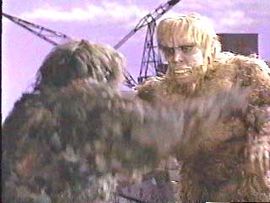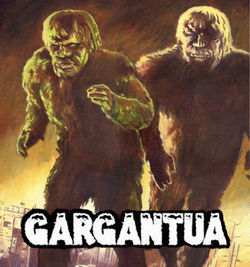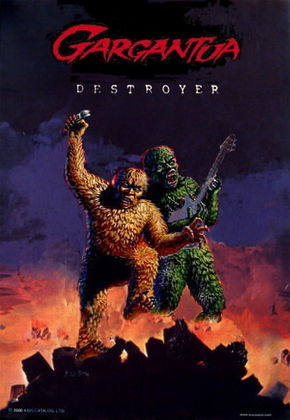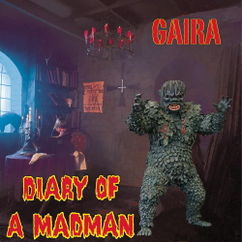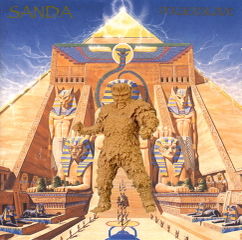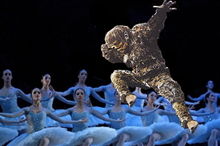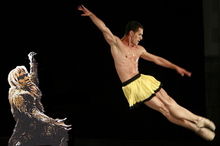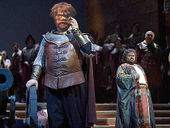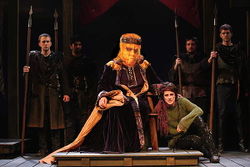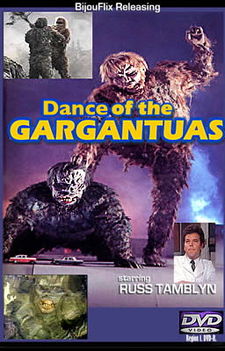The War of the Gargantuas
The War of the Gargantuas, known in Japan as Frankenstein's Monsters: Sanda versus Gaira, refers to the ongoing artistic competition between Sanda and Gaira Gargantua, whose original artistic collaboration "Gargantua" is recognized as one of the pioneering acts in rock history. The feud became public during the dissolution of the band in 1978 and continues to this day. The Gargantuas look similar but Sanda is easily identified by his brown fur while Gaira is slightly shorter and has green fur.
Origins Of The Conflict[edit | edit source]
Sanda and Gaira Gargantua burst onto the music scene in 1970 with the release of the self-titled album "Gargantua". Now considered the first "Heavy Metal" album, "Gargantua" sold millions of copies and skyrocketed the brothers into instant fame and fortune. Gaira's on-stage presence, with his high pitched vocal histrionics and hyperactive leaping, set the standard for a Metal front-man while Sanda's heavy, brooding guitar rhythms and lightning fast solos provided the foundation of what is now considered "Heavy Metal" Rock music.
“Till this day, Sanda is a major influence and inspiration. I have his pictures in my music room and out in my garage, as well as the huge tattoo on my chest. Before we go out on stage we’ll just crank up early Gargantua on the tour bus and it gets us all fired up – especially if you’re a guitar player, you know? It’s like, “Oh, think you can play? Listen to this shit!””
“Back in 1970, Judas Priest had no idea where it was going musically and all of us were unhappy with the first album. Seeing Gargantua at Wembley Stadium that summer proved to be a life transforming experience for me. When Gaira pranced out on stage and began screaming I was awestruck with the spectacle and suddenly realized that this was the musical path I wished to follow. That was also the day I figured out I was gay”
Despite the external appearance of harmony, there was a building animosity between Sanda and Gaira as to who was most responsible for the group's success. These tensions manifested themselves in violent backstage arguments that were witnessed by a few other musicians.
“I've never heard a band scream, shout, rant and rave at each other on an almost nightly basis as soon as they returned to their dressing room. Pretty soon you'd hear loud crashes and the walls being punched out. In this respect they didn't give the impression of being happy bunnies”
Gaira's Cocaine and Alcohol problems soon became legendary in the industry, often consuming more drugs in an hour than Bon Scott, Angus Young and Steven Tyler did in a whole day during their peak. Gaira left an indelible impression on his fellow musicians for incredible hedonistic exploits and occasional Sanda-fueled violence. Sanda's sexual addictions became so rampant backstage that roadies for other bands, male and female, were occasionally overpowered and humped after being mistaken for groupies. This personality dichotomy placed the Gargantua brothers at spiritual and artistic polar opposites, with each often showing disgust for the others' lifestyle backstage while maintaining appearances onstage.
The Demise Of Gargantua[edit | edit source]
By 1978 the Gargantua brothers backstage feud became all too evident both on-stage and in their music. No longer able to collaborate effectively, every song on their "Destroyer" release was either a Gaira rant about Sanda being a "Big Furry Pussy" (Track one) or a 5-minute Sanda guitar solo which included the on-stage stomping of Gaira effigies in concert, which were often lit on fire. During the band's final 1978 concert in Dallas, Gaira secretly filled all of the effigies with dog excrement, inciting such a rage in Sanda that he consequently destroyed the stage and all of the band's equipment. "Destroyer" was universally panned by the critics as pretentious, self-aggrandizing and uninspired. Due to an error in the printing, the Gargantua's colors were reversed by accident and over a million copies were printed before the error was discovered.
Blame for the artistic and commercial failure of "Destroyer" soon became even more contentious and divisive than credit for the band's previous successes. Interviews with the band were suspended after Pittsburgh radio station KROC was almost completely destroyed by a savage battle that erupted between the brothers when Sanda publicly blamed Gaira's drug abuse for the band's artistic demise. Rock critics began fearing the duo when reviewers who panned "Destroyer" had their houses summarily destroyed.
“I awoke one evening to a loud thumping on my front door, after running downstairs to find out what was going on I found a bunch flaming Gaira effigies on my doorstep. Suddenly, the whole house started shaking and crumbled to the ground as I ran for my life”
The final straw came when Gaira refused to participate in Gargantua's final contracted album with Warner Brothers Music Group, setting off a flurry of lawsuits and counter suits from both band members and the record label. The album was never recorded and the label quickly dropped it's lawsuits when the WMG home office in Manhattan was mysteriously destroyed.
Gaira accepted an offer in 1979 from Black Sabbath to replace front-man Ozzy Osbourne and immediately moved on with his career. Sanda decided to take a year off and tour Southeast Asia before continuing with a solo career in the 1980's.
Solo Music Careers[edit | edit source]
Gaira[edit | edit source]
Gaira briefly returned to his songwriting successes of the past with Black Sabbath, taking full credit for the lyrics on "Heaven and Hell" and the band's successful return to prominence without Ozzy. This stint was short-lived after Gaira viciously beat drummer Bill Ward so severely, that the Sabbath veteran was unable to continue on tour. The band fired Gaira mid-tour and he was hastily replaced with Ronnie James Dio, who was forced to lip sync Gaira's pre-recorded vocals. The "Mob Rules" album followed the same successful chemistry with Gaira doing the writing and Dio pretending to sing. Gaira, however, was a front-man by nature and was unhappy with this arrangement, so after writing "Mob Rules" Gaira moved on to form his own solo project.
Gaira's solo career lasted only three albums from an artistic standpoint, with 1983's "Diary Of A Madman" being the last and best album before accidentally killing his guitar player in a 1984 toboggan mishap. Gaira then made the fateful mistake of hiring former "Night Ranger" guitarist Brad Gillis in 1985 and the music went decidedly downhill after that. Fans got into the habit of throwing flaming Gaira effigies on stage during concerts and showing up wearing Sanda masks while chanting "you suck" in-between songs. It was clear that Sanda was winning the public opinion battle with rock fans. Gaira finally realized that his music career was over when he found himself covering Bob Seger's "Turn The Page", a whiny diatribe about how tough it is to be a millionaire rock star. Gaira had clearly lost touch with his audience and in the summer of 1990, "Gaira" officially disbanded and the not-so-jolly green Gargantua finally went into rehab and counseling.
Sanda[edit | edit source]
Sanda's yearlong hiatus after the demise of Gargantua soon turned into three years of touring Southeast Asian brothels. After severely damaging his penis in Thailand, Sanda returned to the United States to renew his musical career. In 1982, Sanda formed his own self-titled band and reignited the competition with his former collaborator and brother. Unfortunately, 1982's "Sanda" and 1983's "Enter Sanda" were poorly received albums, products of the long hiatus for the guitar player who was clearly lacking motivation. In 1984 both Sanda and Gaira were invited to play the "Monsters Of Rock" mega-tour alongside AC/DC, Van Halen and Mötley Crüe. While Sanda was forced to open the show, Gaira was at the peak of his career and commanded headliner status, playing the coveted last show of the day. It was a humiliating experience for Sanda, being upstaged by his brother and being forced to endure the taunts of his heckling fans. After the tour ended Sanda went back into the studio, seething with the rage that once made him famous.
In 1985 Sanda released "Powerslave", an epic album of 70's era power chords combined with flashes of speed metal and hardcore industrial. Old farts who remembered the Gargantua days were appeased while a newer generation of gullible fans thought they were hearing something new and cool. Gaira on the other hand, with Brad Gillis now on lead guitar, released "Barking On The Moon" which lacked energy, angst and depth. The earlier, more popular Gaira material sounded like children banging pots and pans together with Gillis attempting to play it and Gaira's stock plummeted. Meanwhile, Sanda's "Powerslave" concert tour featured huge, elaborate stages, constant pyrotechnics and sharks with lasers on their heads - as well as Sanda shredding on guitar. The climax of Sanda's show featured a 50 foot tall mechanical Gaira bending over and being anally fisted by a giant Sanda robot.
Sanda's run of four triple-platinum albums ended in 1990, soon after the musical retirement of his brother Gaira. Without his muse to inspire him, success faded quickly for Sanda as his creative brand of sibling hatred was now replaced with dopey ballads and love songs. A few years later, he found himself playing county fairs with "The Beach Boys", "Cheap Trick", "Pat Benatar" and other washed up acts. After some soul searching, Sanda realized that his life's calling was to find his brother, make him look bad and urinate on his face.
The Ballet Battle[edit | edit source]
After rehab, Gaira decided to use his prancing talents in the world of dance, far away from the drug fueled lifestyle of the rock star. Utilizing his acrobatic talents, learned from decades of touring, as well as his writing and choreography skills, Gaira took the performing arts world by storm in only his first year with new interpretations of the Ballet classics "Swan Lake" and "The Nutcracker". Surprisingly, his productions drew larger audiences than most seasoned professionals enjoyed, selling out any venue. What was even more surprising were the rave reviews Gaira received by dance critics, well known for panning someone universally seen as an outsider.
“He seems to be the missing link between the old and new, between classical ballet, as we've come to think of it, and theatrical modernism”
Naturally, Sanda attempted to engage his brother in this new Ballet battle but the taller, clumsier Gargantua was definitely not suited for this style of dance. While he excelled in catching flying men in skirts, Sanda clearly wasn't destined for anything better than a Ballet teacher. He quickly conceded this battle and moved into an area of the performing arts in which he felt more adept, Shakespearean acting.
The Shakespeare Conflict[edit | edit source]
While Gaira was prancing around the world, Sanda quickly made a name for himself as one of the world's best Shakespearean actors. His "King Lear" interpretation was heralded by critics and fellow actors as one of the best productions they had ever seen.
“The creation of numerous, new soliloquy parts for King Lear in Sanda's re-write is the first time that I've ever seen Shakespeare improved”
Clearly jealous of his brother's newly found success, Gaira attempted to upstage his brother and decisively claim victory in this new performing arts war. Unfortunately, acting was Gaira's weak spot and critics who had long remained silent due to fear of more "Destroyer" instances could no longer contain themselves as "this furry monkey proceeded to ruin Shakespeare".
“A perfectly lovely evening for "Othello" was ruined by Mr. Gargantua as Iago, who's abusive ad-libs and foul odor was only eclipsed by his ruining of a perfectly good rape scene with his persistent cries of "what's all this then"”
Sanda was back on top, but once again fell into an unsatisfied and depressed state as the victory seemed less enjoyable when the outcome was so convincing and easy. Both brothers now realized that the quest for domination of the other was the fuel that propelled them but achieving that dominance left a cold, lonely world with nobody to fight. The estranged brothers realized that only a collaboration between them provided the proper balance of motivation and success that they desired.
Reunion Tour[edit | edit source]
In 2005, the Gargantuas finally reunited and created a lavishly produced DVD that pays homage to the MGM musicals of the 1950's. With it's mix of high-spirited, acrobatic dance routines and tender, romantic moments "Dance of the Gargantuas" became so popular that the brothers decided to take the show on the road. Generating sold-out performances in every major market, "Gargantuadance" recently became the highest grossing act for 2008, followed closely by The Jonas Brothers. Sanda and Gaira Gargantua are now centered and doing what they love best, fighting each other while entertaining the world.
